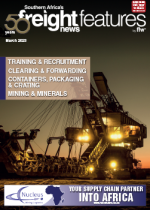Mining volumes are increasingly highlighting the importance of corridors such as that of Beira in Mozambique.According to Marco Grobbelaar, general manager: warehousing and administration, for the Beira Logistics Terminals (BLT), volumes almost doubled in the latter half of 2022. “This has since stabilised due to a combination of factors, including possibly temporary capacity issues being faced at neighbouring country ports. We foresee, however, that volumes will continue to gradually increase as new mining contracts come online or as government restrictions reduce.”Grobbelaar told Freight News that bureaucracy and outdated “paper-heavy” processes continued to impact heavily on the movement of mining commodities in southern Africa, ultimately delaying the loading of trucks at the mines, and the export process to dispatch loaded trucks from the origin country, especially in the Democratic Republic of the Congo (DRC).“What is concerning is that the situation has become worse. The turnaround times from Beira to a DRC mine and back were 32 to 40 days. Currently, that same trip will take anything between 48 and 60 days, depending on the mine you are loading from.”He said more than 65% of a full-cycle dwell time was on the loading and export clearance side. “This has a knock-on effect as it affects the road transport side, creates bottlenecks at borders, and delays trucks from reaching Beira to load import cargo after offloading.” Beira predominantly imports sulphur or ammonium nitrate that needs to get back to the mines. “These delays ultimately push up the customer's supply chain costs, while at the same time causing havoc in the warehousing sector, as we are simply unable to free up space quickly enough to accommodate new cargo.”Grobbelaar says despite the challenges, the mining sector holds major opportunities for the logistics sector. “One of the issues is the fact that logistics systems are simply not able to meet demand at present. This speaks directly to the interest in the sector. BLT has therefore invested a lot of time and money over the past few years to train and develop an impeccable team and implement state-of-the-art systems and procedures for high-value cargo to service the sector efficiently. We continue to do so as the industry evolves and strive to stay ahead of technology and operational efficiencies.”He says reducing or eliminating “ human error” is critical when it comes to high-value mineral c om mod it ie s. “ We try to automate as much as possible, which has also contributed to improved security, transparency with live reporting and forecasts, truck turnaround times, and throughput with export packing of containers.”Explaining the process, Grobbelaar said when a truck with high-value cargo departed a mine, individual items were already pre-allocated into their system per truck, per trailer and an expected weight – all before the vehicles have crossed the first transit border en-route to Mozambique.“Each item also already has its own bar-coded label waiting for it, with a bin location pre-allocated to facilitate the operations after the truck arrives. We have stages set up in our system that show you exactly at any given time what the status is of any given item, and also have cross-reference locks in place between platform scales and our 70-ton weighbridges to f lag specific variances from the criteria we set. Creation of packing lists and physical packing is f lawless, with items being scanned into containers in real-time (via our mobile app), which makes life easier for our employees and customers.”These capabilities will be of extreme importance for the sector, which is not expected to show any slowdown as demand worldwide for minerals continues to skyrocket. Koen said southern Africa was home to a wide range of critical minerals that would see the region grow in importance.“We are already seeing lithium reserves out of Zimbabwe on the rise, as well as increased volumes of cobalt out of the DRC.”

